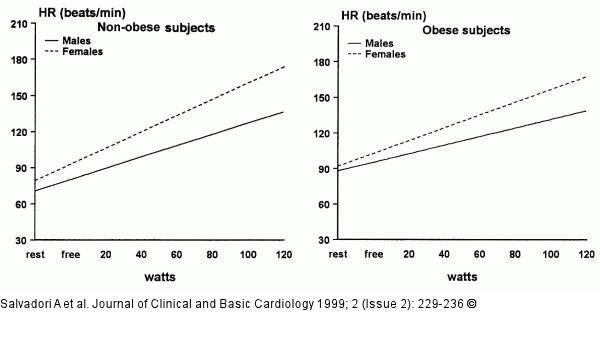Salvadori A, Arreghini M, Bolla G, Fanari P, Giacomotti E, Longhini E, Miserocchi G, Palmulli P Cardiovascular and adrenergic response to exercise in obese subjects Journal of Clinical and Basic Cardiology 1999; 2 (2): 229-236 PDF Summary Overview
| ||||||||||||||||
Figure/Graphic 2: Herzfrequenz - Adipositas Heart rate (HR) vs. watt relationship in non-obese and obese males and females. The regression lines were: HR = 90.7 + 0.7 watt - 14.2Z2 - 0.2 wattZ2 (R2: 0.8; F: 205; MSE: 248) in the control group, and: HR = 98 + 0.6 watt - 5.8Z2 - 0.2 wattZ2 (R2: 0.8; F: 180; MSE: 145) in the obese group, with a dummy variable Z2 = 1 for males and 0 for females because the two regression lines have significantly different slopes (P < 0.001) |

Figure/Graphic 2: Herzfrequenz - Adipositas
Heart rate (HR) vs. watt relationship in non-obese and obese males and females. The regression lines were: HR = 90.7 + 0.7 watt - 14.2Z2 - 0.2 wattZ2 (R2: 0.8; F: 205; MSE: 248) in the control group, and: HR = 98 + 0.6 watt - 5.8Z2 - 0.2 wattZ2 (R2: 0.8; F: 180; MSE: 145) in the obese group, with a dummy variable Z2 = 1 for males and 0 for females because the two regression lines have significantly different slopes (P < 0.001) |







